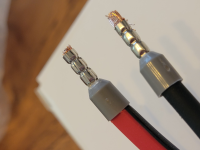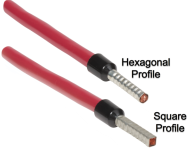Hi,
I'm planning to build Troels Gravesen The loudspeaker 3, the drivers has arrived. The bass unit - 18 Sound 15W700, has spring loaded connectors with big holes.
What is the best way to connect the speaker cables, do I just strip the wire and let the spring make the connection, or shall I put banana plugs on the cables and push them through the hole? I feel like this is a stupid question but I want to make sure the cables don't come loose .
There are plastic caps on the top of the connections, similar to speaker terminals but I don't think these are to be removed, as there would be no way to differentiate between the positive and negative terminals.
Thanks for your help.
I'm planning to build Troels Gravesen The loudspeaker 3, the drivers has arrived. The bass unit - 18 Sound 15W700, has spring loaded connectors with big holes.
What is the best way to connect the speaker cables, do I just strip the wire and let the spring make the connection, or shall I put banana plugs on the cables and push them through the hole? I feel like this is a stupid question but I want to make sure the cables don't come loose .
There are plastic caps on the top of the connections, similar to speaker terminals but I don't think these are to be removed, as there would be no way to differentiate between the positive and negative terminals.
Thanks for your help.
Yes strip the wire just long enough and insert through the terminal hole created when the button is prressed, this holds the wire very tightly and creates a large contact patch.
Twist the stranded conductors tightly before trying to insert them into the connector.
Or else lightly tin just the very end (no more than 3 mm) of the bare wire, so the strands cannot splay outward.
Or else lightly tin just the very end (no more than 3 mm) of the bare wire, so the strands cannot splay outward.
Thanks everyone. I'm going to use female spade connectors for the other drivers, as I don't like the magnets pulling the soldering ironing, if I try to solder the cable directly to the terminal. Hopefully this is fine, as most manufactures seem to use this technique.
If the terminal holes are large enough to accept banana plugs as you indicate, then yes, do that. I've never seen holes that large.
If the speaker cable is very thin compared to the holes in the terminals then you can strip it back further, twist and fold back on itself to give the terminal something thicker to hold onto. (electrician at work does this with 1mm2 cable in light switches etc)
Rob.
Rob.
I'm going to revive this thread to avoid polluting another. I just received 4 10" drivers with push connectors. I can see that the spring loaded connections will be pretty solid, but is there any concern over oxidation in the long term? I would prefer not to have to take the cabinets apart later on.
I've seen flexible pin connectors, with screws. They screw the wire down but then use a braided end. The issue with those seems to be the small conductor that you are left with.
Can someone help me feel more confident about using bare wire?
Thank you.
I've seen flexible pin connectors, with screws. They screw the wire down but then use a braided end. The issue with those seems to be the small conductor that you are left with.
Can someone help me feel more confident about using bare wire?
Thank you.
It's probably not a big deal... I've not seen a plethora of threads in over a decade of being online (two decades actually) where people complain about oxidation on these types of spring terminals. Having said that, were I to connect a driver that had these spring terminals, I would use stranded copper wire, properly terminated (i.e. with good tooling) with pin terminals. Then the pins go into those terminals.
https://www.digikey.ca/en/products/detail/te-connectivity-amp-connectors/160404-2/1864407
With enough contact pressure, spring terminations on these softer metals is generally considered gas-tight, and tin coatings are fine given the amplitude of signal expected for drivers with spring terminals.
https://www.digikey.ca/en/products/detail/te-connectivity-amp-connectors/160404-2/1864407
With enough contact pressure, spring terminations on these softer metals is generally considered gas-tight, and tin coatings are fine given the amplitude of signal expected for drivers with spring terminals.
Last edited:
A crimp connection (or compression connection) is very reliable if done correctly. A dielectric spray can be used on the bare wires to greatly reduce any corrosion or oxidation. There are a lot of good dielectric sprays on the market, but they are all very similar. Even WD-40 works well, but not as well as something like LPS-1 or Boeshield T-9.Can someone help me feel more confident about using bare wire?
I have crimped ring terminals and butt connectors using Boeshield T-9 on the bare wires, then covered the joint in heat shrink, and installed the wiring in the bilge space of a boat where the wire was exposed continuously to a moist corrosive environment. Even after a decade, there is no problem.
j.
Thanks so much for the tip on an oxidation inhibitor!I have crimped ring terminals and butt connectors using Boeshield T-9 on the bare wires, then covered the joint in heat shrink, and installed the wiring in the bilge space of a boat where the wire was exposed continuously to a moist corrosive environment. Even after a decade, there is no problem.
https://eecoonline.com/shop/BBCTB8Can someone help me feel more confident about using bare wire?
https://empower.abb.com/ecatalog/ec/EN_NA/p/CTB8
This stuff will last 50 years+ in a lot gnarlier conditions the loudspeaker enclosures.
Just coat the wires sparigly.
Any type of grease like that will attract dust so keep stuffing like fibreglass fibers etc away from it somehow if you use it.
It will "dry" eventually for lack of a better word.
Alle the oxide inhibitors have a temp range one should be aware of for use.
Thanks to the suggestions and ideas above I've ordered these. I'm not sure if it's better than bare wire, but it really feeds my tool addiction. 😉 The fit in the spring connector is nearly perfect.

Here they are on some cheapy 12 gauge speaker cable. I have to say they look great and fit really nicely. Everything feels tight and reliable. The crimps don't feel like they will ever come out and the spring loaded terminals feel like they have an excellent "bite" that's also not about to shake loose anytime soon. Also I now have an excuse to buy a bigger tool chest...



That is what is used for multistrand wires most places.Thanks to the suggestions and ideas above I've ordered these. I'm not sure if it's better than bare wire, but it really feeds my tool addiction. 😉 The fit in the spring connector is nearly perfect.
A lot better then the bare multistrand in terms of contact surface, geometric stability and no wear and tear on fine multistrand conductors.
Only use Knipex, Weidmuller's products so the specific brand i know nothing of.
The 'Crimper' is of a 'good' basic design looks like a Knipex copy 0,25-6mm2.
But your crimps looks like the set screw is too tight.
They should look like the picture below ca.
That is some serious bumps, on them. too much wire sticking out. And i don't know your specific crimper but visually it looks like it should be hexagonal when it is done ?
They should look like the picture below, and the pic in 'your ad'.
Nothing wrong with double crimping. And ALWAYS do a pull test on them after.
Little point, depends on volume of use. The return sping for the mechanism will at some point stretch so much it will stop doing it's purpose.
Then it won't crimp tightly and properly anymore and is ready for the bin.
Have worn out several crimpers like that over the years, but not for diy purposes.

A lot better then the bare multistrand in terms of contact surface, geometric stability and no wear and tear on fine multistrand conductors.
Good to know!! It feels good to me.
But your crimps looks like the set screw is too tight.
They should look like the picture below ca.
That is some serious bumps, on them. too much wire sticking out. And i don't know your specific crimper but visually it looks like it should be hexagonal when it is done ?
Is it bad to be too tight?? How do I judge correct pressure?
🤔
I'll trim the edges and try to get better pics. I did leave too much in. I was kind of seeing if I could get wires to stick out the opposite side of the jack.
Is it bad to be too tight??
If the crimp is so aggressively tight that some of the wire strands are cut inside the crimp, then yes it is too tight. Another possible failure mode with too-tight of crimping is the ferrule can have very small cracks, which grow over time, eventually leading to failure.
Your crimp looks like it might be too tight 🙁
well i'd say it looks too tight, because the bulging from the crimp is too strong.Is it bad to be too tight??
Better with a even crimp that ensures a higher contact surface.
Assuming the AWG/mm2 size is correct of course, if the ferrule is oversized to the conductor it will tend to look a little like that.
The 'valleys' (red) are in contact and crimped around the conductor.
Look at the dimensional difference between the 'peaks' and 'valleys'. There is no way you have a even contact surface in the whole ferrule.
So the valleys are touching the conductors. But the bulging part/peaks are in contact with air from how it looks like.
Not anything detrimental unless you run a lot of Electrical effect through it (Kw) (more then your drivers will handle ).
You have the +/- wheel on the handle to adjust tension with for the crimp.
Also worth trying double crimping and see if it evens out. Crimp, rotate/move out a bit and once more.
If you are into tools, and you do some cable work:
https://www.bahco.com/int_en/cable-...d-handles-for-cu-and-al-cables-pb_2233d_.html
Best stripper type/format that exist for 'small' work.
Just soft metal so only use it for Cu, Al, and softer materials.
Might be a bit too sharp as they come, as you are likely to cut some off before you get the hang of it.
Turns out that the next size down does fit better, but the crimp is probably still a little too tight. The wire bundle doesn't have the same amount of empty space at the end. I'll attempt to loosen up the crimps by a notch or two. Thanks for the advice!
What do you think? Looks significantly better, no? I have not yet adjusted the crimp pressure, just using the 14 gauge (blue) ferrule on the same gauge wire.
- Home
- Loudspeakers
- Multi-Way
- How to connect driver with spring loaded connectors